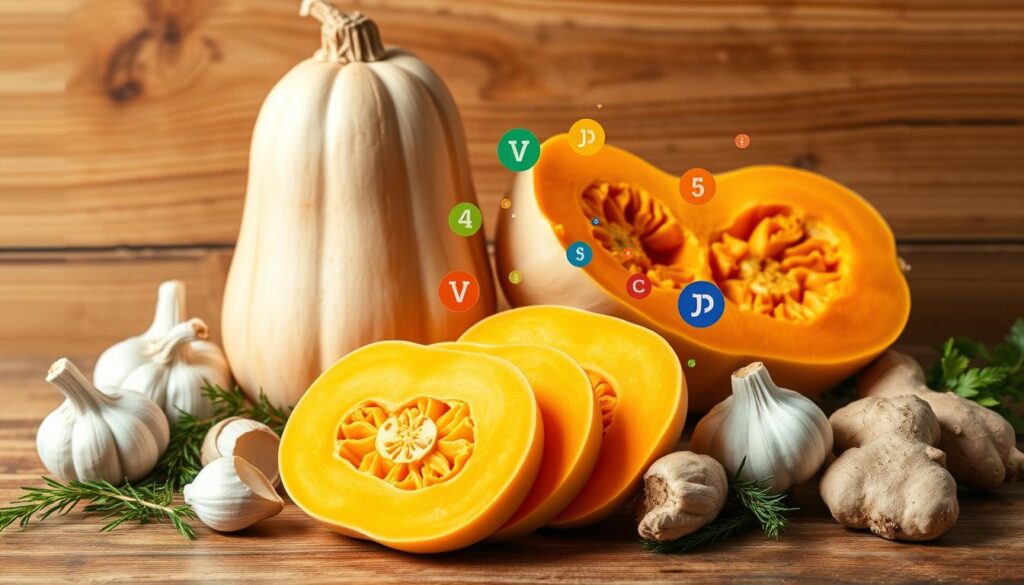When the air gets cool and leaves start to turn, nothing warms your heart like butternut squash soup. This vibrant, creamy soup is the perfect fall treat. It’s perfect for cozying up at home or sharing with friends.
Key Takeaways
- Butternut squash soup is a quintessential fall dish, offering creamy comfort and warm flavors.
- This soup is highly customizable, allowing for various flavor additions and garnishes.
- Butternut squash is a nutritious, plant-based ingredient that provides a boost of vitamins and antioxidants.
- The soup can be made on the stovetop, in a slow cooker, or using an Instant Pot for added convenience.
- Proper storage and reheating techniques ensure you can enjoy the soup’s delicious flavors for days to come.
Introduction to Butternut Squash Soup
Butternut squash soup is a rich, creamy dish loved in fall and winter. It’s not just tasty but also full of nutrients. Whether you’re a pro or a beginner, you’ll love making and eating this soup.
What is Butternut Squash Soup?
This soup is made from butternut squash, known for its orange flesh and nutty taste. It’s blended with herbs and spices, creating a sweet and savory mix.
Why You Should Love It
- Delicious and comforting: It’s a true comfort food, offering a soothing experience.
- Nutritious: It’s full of vitamins, minerals, and antioxidants, making it healthy.
- Versatile: You can make it in many ways, from classic to creative.
- Seasonal appeal: It celebrates the harvest season and the cozy months.
“Butternut squash soup is the ultimate hug in a bowl – it’s warm, comforting, and utterly delicious.”
Looking for a nourishing meal or a holiday dish? Butternut squash soup is perfect. It’s delicious and good for you.
Health Benefits of Butternut Squash
Butternut squash is a nutrient-rich winter vegetable. It’s full of vitamins, minerals, and antioxidants. These nutrients support overall health. Butternut squash soup is a tasty way to get these benefits in your diet.
Nutritional Value
Butternut squash is packed with vitamins and minerals. One cup of cooked squash has about 82 calories. It also has 6.6 grams of fiber and over 100% of vitamin A.
It’s also a good source of vitamin C, magnesium, potassium, and calcium. These nutrients are important for our health.
Antioxidants and Vitamins
The orange color of butternut squash shows it’s full of carotenoids. Beta-carotene is a key antioxidant. It fights inflammation and protects our eyes.
Butternut squash is also rich in vitamins A and C. These vitamins boost our immune system and keep our skin healthy.
Fiber and Digestion
Butternut squash has a lot of fiber. This fiber helps our digestive system stay healthy. It keeps our bowels regular and supports good gut bacteria.
Eating butternut squash with other fiber-rich foods can make it even better for digestion.
“Butternut squash is a nutritional powerhouse that can be enjoyed in a variety of hearty vegetable soups and plant-based comfort food dishes.”
Ingredients You’ll Need
Making a comforting butternut squash soup at home is simple. You’ll need a few key ingredients to create this seasonal fall dish:
Fresh Butternut Squash
A large (about 3-pound) butternut squash is the main ingredient. Peel, core, and chop it into ½-inch cubes for even cooking.
Aromatics and Seasonings
Diced yellow onion, minced garlic, and fresh herbs like sage, thyme, or rosemary add flavor. Don’t forget smoked paprika, salt, and pepper for seasoning.
Optional Add-Ins
- Butter or olive oil for sautéing
- Heavy cream or coconut milk for a richer texture
- Brown sugar for a touch of sweetness
- Thai curry paste or miso paste for global flavors
- Apple cider or pumpkin spice blend for seasonal flair
With these ingredients, you’re ready to make a delicious homemade butternut squash soup. Let’s move on to the preparation steps!
How to Choose the Right Butternut Squash
As the seasons change, we look forward to winter squash recipes and seasonal dishes. Choosing the right butternut squash is key. It makes a big difference in making a creamy, flavorful soup that feels like autumn. Here’s how to pick the best squash.
Selecting a Ripe Squash
When picking a butternut squash, look for one that’s heavy and has a firm, smooth skin. Larger squashes give you more flesh, making the soup creamier. Choose squashes with a long neck and a small bulb for more usable squash and less pulp.
Storage Tips
- Store whole, uncut butternut squash in a cool, dry place for up to a month.
- Once you’ve cut the squash, wrap the remaining portions tightly and refrigerate for up to a week.
By following these tips, you’ll find the perfect butternut squash for your autumn cooking. With the right squash, you can explore delicious winter squash recipes and seasonal dishes. They will warm your heart and excite your taste buds.
Preparation Steps for Delicious Soup
Starting with a creamy, flavorful roasted butternut squash soup requires the right prep. First, peel and cut the squash into 1-inch cubes. You can find pre-cut squash at many grocery stores to make things easier.
Then, sauté the ingredients that will be the soup’s base. In a big pot or Dutch oven, melt butter or heat olive oil. Add diced onions, carrots, and crushed garlic. Cook until they’re soft and lightly browned. This step creates a rich, savory base for your soup.
Roasting the squash cubes is an optional but great step. Roast them at 425°F for 40-50 minutes. This brings out the squash’s natural sweetness and adds deeper flavors to your roasted butternut squash soup. It takes a bit longer, but it’s worth it for the flavor.
Over 500 reviews have given this butternut squash soup recipe a 5-star rating, indicating its exceptional quality and crowd-pleasing appeal.
With the squash ready and the aromatics sautéed, you’re almost there. You’re on your way to making a delicious hearty vegetable soups that will warm you up on a chilly fall day.
Cooking Methods for Butternut Squash Soup
There are many ways to make a delicious butternut squash soup. You can use a slow cooker, Instant Pot, or the stovetop. Each method has its own benefits, like flavor and convenience.
Stovetop Cooking
For a traditional butternut squash soup, just simmer the squash with broth and spices for 20-30 minutes. This lets you watch the soup closely, ensuring great flavors. After the squash is soft, blend it until creamy.
Using a Slow Cooker
The slow cooker is great for a hands-off butternut squash soup. Just put the squash, broth, and spices in it. Let it cook on low for 4-6 hours. Then, blend it until smooth.
Instant Pot Recipe
The Instant Pot makes butternut squash soup quick and easy. Sauté the aromatics, then add the squash and broth. Cook for 8 minutes, then quick release. Blend until smooth for a tasty vegetarian soup recipe.
No matter the method, blending until smooth is key. This makes your butternut squash soup creamy and comforting. It’s perfect for a cool autumn day.
Tips for Achieving Creamy Texture
Enjoying a creamy pumpkin soup or any plant-based comfort food is a treat. The velvety, lush texture is what makes it special. To get this creamy feel in your homemade butternut squash soup, try a few techniques.
Blending Techniques
For a silky-smooth soup, use an immersion blender right in the pot. Or blend it in batches with a high-powered stand blender. But be careful with hot liquids to avoid splatters. Blending the cooked veggies well is key to a creamy texture without too much fat.
Adding Cream or Alternatives
To make it even creamier, add a bit of heavy cream, coconut milk, or a dairy-free option like cashew cream. Start with 1 cup and add more as needed. For a lighter touch, Greek yogurt or pureed tofu can also add richness to your plant-based comfort food.
The secret to a creamy pumpkin soup is balancing the natural creaminess of the veggies with extra dairy or non-dairy. Play around and find what you like best.
Flavor Variations to Try
As autumn comes, why not spice up your butternut squash soup with new flavors? Try these autumn soup ideas and seasonal fall dishes to excite your taste buds.
Spicy Butternut Squash Soup
Add a spicy touch with Calabrian chili paste or chipotle peppers. This will give your butternut squash soup a nice heat. It matches the squash’s natural sweetness perfectly.
Curry-Infused Option
Bring in the warm, aromatic taste of curry. Use Thai red or yellow curry paste, or a mix of curry powder, cumin, and coriander. This adds a rich flavor to your seasonal fall dish.
Herb-Infused Variations
Fresh herbs can make your butternut squash soup even better. Add chopped sage, thyme, or rosemary towards the end. This gives a comforting, earthy taste to your autumn soup.
Try adding diced apple or fennel for a nice crunch and sweetness. A sprinkle of cinnamon and nutmeg adds a cozy touch to your butternut squash soup.
“Embracing the season’s bounty and experimenting with different flavors can transform a humble butternut squash soup into a truly remarkable autumn soup idea.”
Serving Suggestions
There are many ways to serve your delicious butternut squash soup. It’s a perfect dish for autumn, pairing well with various sides and garnishes. These additions make your meal cozy and satisfying.
Ideal Pairings
Pair your soup with a fresh salad or crusty bread for dipping. It also goes great with grilled cheese sandwiches, making for a cozy meal. For a special touch, serve it in a mini pumpkin or squash. This adds a seasonal flair to your dish.
Garnishing Tips
- Drizzle with a swirl of cream or yogurt for a creamy contrast.
- Top with crunchy croutons or roasted pumpkin seeds for textural interest.
- Sprinkle with chopped fresh herbs like cilantro, parsley, or thyme for a burst of flavor.
- Add a squeeze of fresh lime juice to brighten the soup’s richness.
- Crumble feta or goat cheese over the top for a tangy, creamy finish.
Try different garnishes and pairings to make your butternut squash soup a highlight of autumn. It’s a great way to enjoy the season’s comforting flavors.
Storing and Reheating Leftovers
Butternut squash soup’s rich flavors can last beyond the first bowl. With the right storage, you can enjoy it for days. Follow these tips to keep your soup fresh.
Proper Storage Techniques
Transfer leftovers to an airtight container and refrigerate for 4-5 days. For longer storage, freeze for 3-4 months. Leave some space in the container for expansion.
Best Ways to Reheat
Reheat the soup gently on the stovetop. Use a saucepan and heat over medium, stirring often. If it’s too thick, add a bit of broth or water. Avoid boiling to prevent separation.
These tips will help you enjoy your butternut squash soup for longer. Whether for dinner or in other seasonal fall dishes, you’ll get the most from your soup.
| Nutritional Information (per serving) | Value | % Daily Value |
|---|---|---|
| Calories | 206 | – |
| Total Fat | 11 g | 17.9% |
| Saturated Fat | 8 g | 32.5% |
| Carbohydrates | 24 g | 8.0% |
| Fiber | 3.7 g | 15.0% |
| Protein | 19 g | 12.6% |
| Sodium | 407.8 mg | 17.0% |
Conclusion: Enjoying Your Butternut Squash Soup
Butternut squash soup is a true fall delight. It’s both comforting and nutritious. You can make it your own by adding your favorite flavors.
Embracing Fall Flavors
As fall arrives, this soup becomes a favorite. Its creamy texture and warm spices bring back cozy memories. It’s perfect for any meal, especially on cool days.
Final Thoughts on Homemade Soup
Making your own butternut squash soup lets you choose the ingredients and flavors. With a little practice, you’ll create a dish that wows everyone. Enjoy the process and the delicious results of your homemade soup.



